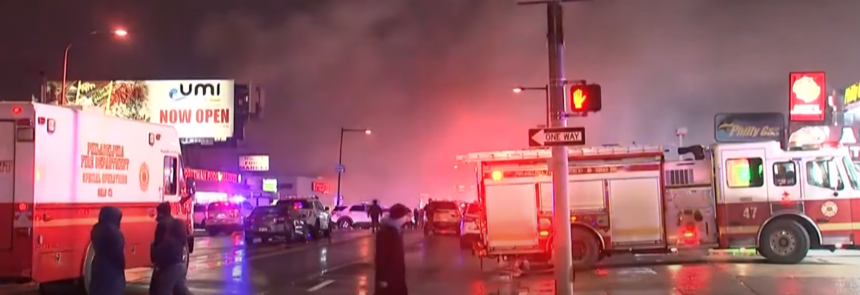A tragic plane crash in Northeast Philadelphia has shocked the local community, raising urgent questions about aviation safety and emergency response protocols. On the evening of January 31, 2025, a medical transport jet carrying six individuals, including a pediatric patient, crashed shortly after taking off from Northeast Philadelphia Airport. The aircraft, a Learjet 55, went down around 6:30 p.m., impacting the bustling intersection of Cottman Avenue and Bustleton Avenue, near the Roosevelt Mall. The crash ignited a massive fire, causing severe damage to multiple homes and endangering residents in the area.
The Devastating Crash and Immediate Aftermath
According to aviation officials, the aircraft had just departed and was en route to Mexico, with a planned stop in Missouri before reaching its final destination in Tijuana. The pediatric patient, who had been receiving critical medical treatment in Philadelphia, was being transported back home. Tragically, all six people aboard were Mexican nationals, including two medical professionals and the flight crew.
Eyewitnesses reported hearing a loud explosion followed by intense flames and thick black smoke rising from the crash site. Residents rushed out of their homes as emergency responders, including firefighters, paramedics, and police, arrived at the chaotic scene. The impact of the crash not only engulfed the aircraft in flames but also damaged nearby houses and forced evacuations in the neighborhood.
The Federal Aviation Administration (FAA) and National Transportation Safety Board (NTSB) have launched a full-scale investigation into what caused the jet to lose control and crash moments after takeoff. Investigators will examine flight data, maintenance records, and pilot communication to determine the exact cause of the accident.
Potential Causes Being Investigated
Although the official cause has not yet been determined, aviation experts are considering multiple possibilities, including:
- Mechanical Failure: Investigators will analyze aircraft maintenance logs and determine whether engine failure, electrical issues, or fuel system malfunctions contributed to the crash.
- Pilot Error: The flight crew’s final moments and cockpit communications will be reviewed carefully to understand whether human error played a role.
- Weather Conditions: While initial reports indicate calm conditions, even slight turbulence or unexpected wind patterns could have affected the flight’s stability.
- Weight and Balance Issues: Since the aircraft was a medical transport jet, carrying specialized equipment, medical staff, and a patient, the distribution of weight will be investigated.
Community Impact and Emergency Response
The Philadelphia Fire Department dispatched over 100 firefighters to the scene, battling the raging fire caused by the crash. Their quick response helped prevent further casualties and contained the damage to nearby residential areas. The National Guard and local emergency management teams were also deployed to assist with recovery efforts.
Many residents have lost their homes or sustained significant property damage, prompting disaster relief efforts from local organizations and charities. The City of Philadelphia has set up emergency shelters for displaced residents and is working to provide financial assistance to those affected.
Philadelphia Mayor Cherelle Parker expressed deep sorrow over the tragic event, stating, “Our hearts go out to the families of the victims and the residents affected by this devastating accident. We are committed to supporting everyone involved and ensuring a full investigation into the cause of this crash.“
Aviation Safety Concerns and Past Incidents
This latest aviation tragedy has reignited discussions about the safety of small private jets, particularly those used for medical transport operations. Learjet 55 aircraft, though widely used, have had previous incidents of mechanical failures and crashes.
Philadelphia has also witnessed similar aviation accidents in the past, including the 2018 Southwest Airlines engine explosion that resulted in the death of a passenger after an engine failure mid-flight. The latest crash raises concerns about aircraft safety protocols at smaller airports like Northeast Philadelphia Airport, which handles private and medical transport flights rather than commercial airlines.
Ongoing Investigation and Next Steps
The NTSB and FAA are expected to release a preliminary report within the next two weeks, followed by a detailed final report within several months. The black box flight recorder, if recovered, will provide crucial data on the aircraft’s final moments.
What This Means for Medical Air Transport Safety
The tragedy also raises questions about safety regulations for medical air transport services. The demand for private medical flights has increased, but there have been growing concerns over pilot fatigue, aircraft maintenance, and emergency preparedness. Experts suggest that stricter regulations and oversight are needed to prevent such accidents in the future.
How Families and the Community Can Get Support
Families of the victims are being assisted by Mexican consulate officials, while local organizations and charities have started relief efforts for affected residents. The Philadelphia Office of Emergency Management has launched a support fund, allowing people to donate to families who lost their homes.
Those seeking assistance or more information about the crash can contact:
- FAA Investigation Hotline – 1-866-835-5322
- Philadelphia Disaster Relief Fund – phila.gov/disasterfund
- Local Emergency Shelters – Available at Roosevelt Community Center
Conclusion: A Tragic Reminder of Aviation Risks
The Philadelphia plane crash is a devastating reminder of the risks associated with air travel, particularly medical transport flights. As the NTSB and FAA investigations continue, families, aviation experts, and safety officials are waiting for answers that could lead to improved regulations and safety measures.
With six lives lost, this incident will leave a lasting impact on Philadelphia residents, aviation authorities, and medical transport operators worldwide. In the coming weeks, more details will emerge, but for now, the focus remains on supporting the victims’ families and ensuring that similar tragedies do not happen in the future.






